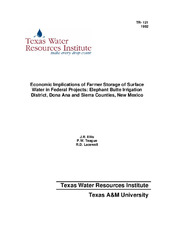| dc.description.abstract | This study estimated the expected regional impact and economic feasibility of a proposed water accumulation or water saving option for agricultural producers operating in the Elephant Butte Irrigation District in southern New Mexico. The water accumulation plan would allow agricultural producers to retain part of a given year's surface water allocation in Elephant Butte Reservoir, providing use of the unevaporated portion in a later year.
The analysis was based upon modeling of current cropping practices subject to regional resource constraints within a static linear programming model. Pertinent input/output coefficients and costs were incorporated, with five-year (1976-1980) average output prices assumed for twelve crops spread across 11 soil groups. Applicable fixed costs and interest charges were taken into account. Net returns to the region were maximized assuming 1 and 3 acre-feet of groundwater available per year per acre irrigated.
Surface water availability was varied from zero to 3 acre-feet per acre to obtain schedules depicting regional net returns and cropping patterns for varying surface water allocations for both the groundwater situations examined. These schedules were then used to build temporal linear programming models which maximized the present value of net returns for the period 1963 to 1980 subject to historical surface water allocations and reservoir evaporation rates. Calculation of these evaporation rates took into consideration increased lake levels due to surface water storage.
The temporal models were used to estimate an optimal allocation of surface water over the 18 year period investigated for the two groundwater availability situations considered. Returns for the optimal surface water allocations were then upper bounds on potential net returns to the region. Projected streams of net returns were also obtained for each of the scenarios analyzed; i.e., optimal temporal allocation of surface water, 2 acre feet of surface water per year limit and actual allocation of surface water given the 1 and 3 foot groundwater limitations. These streams of net returns were valued in 1980 dollars allowing comparison among the alternative scenarios. Differences between the various returns streams for each groundwater situation provided a measure of possible economic effects of the water saving program.
Results of the study for current groundwater availability conditions indicate that optimally temporal allocated surface water use would increase average annualized net returns per acre from that of the actual surface water allocation by .82 dollars per year, or less than .2 %. Use of the more realistic two acre-foot per acre limit on surface water use led to an increase in annualized net returns of only .23 dollars per acre per year. Both increases were deemed insufficient to cover anticipated administrative costs of the program.
Under conditions of limited groundwater availability (1 acre-foot per acre), percentage increases in annualized net returns over those for the actual surface water allocation were more significant. Use of the water saving option and perfect knowledge of future surface water allocations resulted in increased annualized net returns of $8.41 per acre per year for an increase of 54 z. For the two acre-foot surface water use limitation case, annualized net returns increased by $3.68 per acre per year (23.7 %). In all cases considered, groundwater use increased with use of the water saving option. These economic results, coupled with possible political obstacles faced by the program, suggested that alternative water management schemes should be considered. | en |


